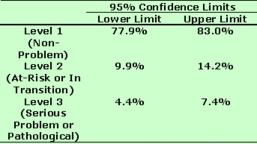Recent issues of the WAGER have presented studies of special groups of youths: delinquents (Vol. 7, No. 1), marijuana users (Vol. 6, No. 49), older, post-high school youths (Vol. 6, No. 23), and
Canadian school youth (Vol. 6, No. 10). Our understanding of problem gambling among special populations can be furthered by determining the overall prevalence of problem gambling in adolescents. This WAGER presents the prevalence of adolescent problem gambling as estimated by a meta-analysis of prevalence studies (Shaffer & Hall, 1996).
Shaffer and Hall (1996) conducted a meta-analysis of youth gambling prevalence studies by reviewing and summarizing reference databases (i.e., Medline, Psyclit), collections of unpublished studies, and every issue of the Journal of Gambling Studies through the Winter 1993 issue. Any study that focused on the prevalence of adolescent gambling in North America was eligible. They identified and analyzed 11 studies that surveyed adolescents from 13 to 20 years of age. The studies varied methodologically in a number of ways including: sampling methods, screening instruments, and geographic regions of North America.
Shaffer and Hall found no statistically significant differences among published rates of problem gambling1. They reported the 95% confidence intervals of the median prevalence for each of the three levels of gambling behavior (See Table 1).
Table 1. Adolescent Gambling Prevalence Estimate
The authors reported that in 95 observations out of 100, between 4.4% and 7.4% of adolescents will experience serious problems with gambling. This places the adolescent lifetime Level 3 prevalence estimate higher than the 1.92% from a similar meta-analysis of adult population studies (Shaffer & Hall, 2000). This might mean that there is a more acute gambling problem within the adolescent population as a whole compared to adults. However, the authors noted that these numbers should be interpreted with caution, given the wide methodological variety among the relatively small number of studies. In addition, several studies used the SOGS-RA to assess gambling problems. Research by Ladouceur et al (2000) suggested that the SOGS-RA inflates the number of adolescents with gambling problems due to the adolescents’ misunderstanding of some of the items. Inflated prevalence estimates in the original studies would increase the prevalence estimated by this meta-analysis.
Despite the limitations, this study makes an important contribution to the addictions field. In the absence of a gold-standard, the aggregated outcomes of several studies should provide a stable expectation of the rate of problem gambling among adolescents. The comparatively high-level of problem gambling among youth presents not only a public-health concern but also a concern for the difficulty of measuring adolescent problem behaviors.
Notes
1. They did find, however, that prevalence rates differed between published and unpublished studies. Published studies reported higher estimates of gambling problems in adolescents than unpublished reports.
References
Ladouceur, R., Bouchard, C., Rhéaume, N., Jacques, C., Ferland, F., LeBlond, J., & Walker, M. (2000). Is the SOGS an accurate measure of pathological gambling among children, adolescents and adults? Journal of Gambling Studies, 16(1), 1-24.
Shaffer, H., & Hall, M. (2000). Updating and refining meta-analytic prevalence estimates of disordered gambling behavior in the United States and Canada. Boston: Harvard Medical School – Division on Addictions.
Shaffer, H. J., & Hall, M. H. (1996). Estimating the prevalence of adolescent gambling disorders: A quantitative synthesis and guide toward standard gambling nomenclature. Journal of Gambling Studies, 12(2), 193-214.





